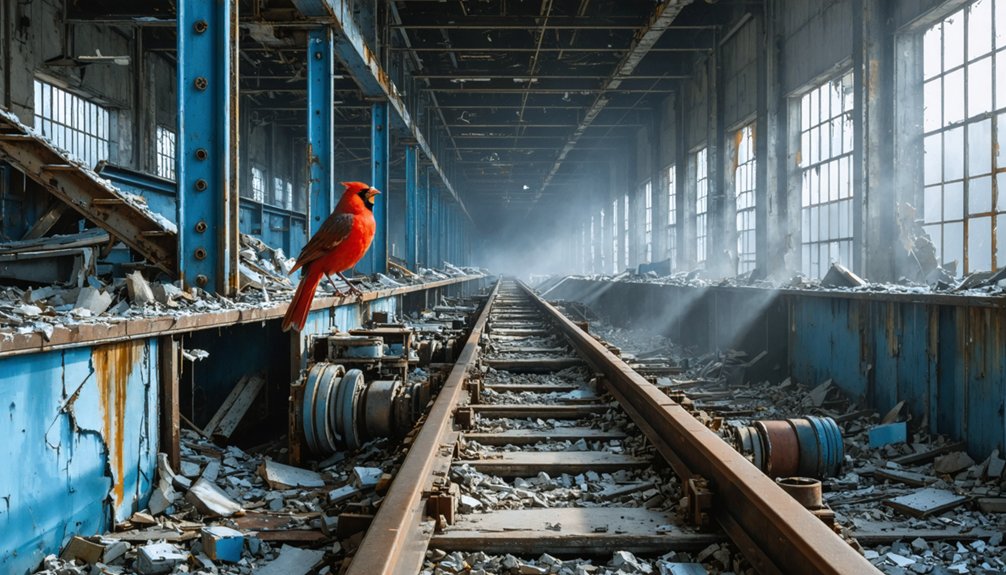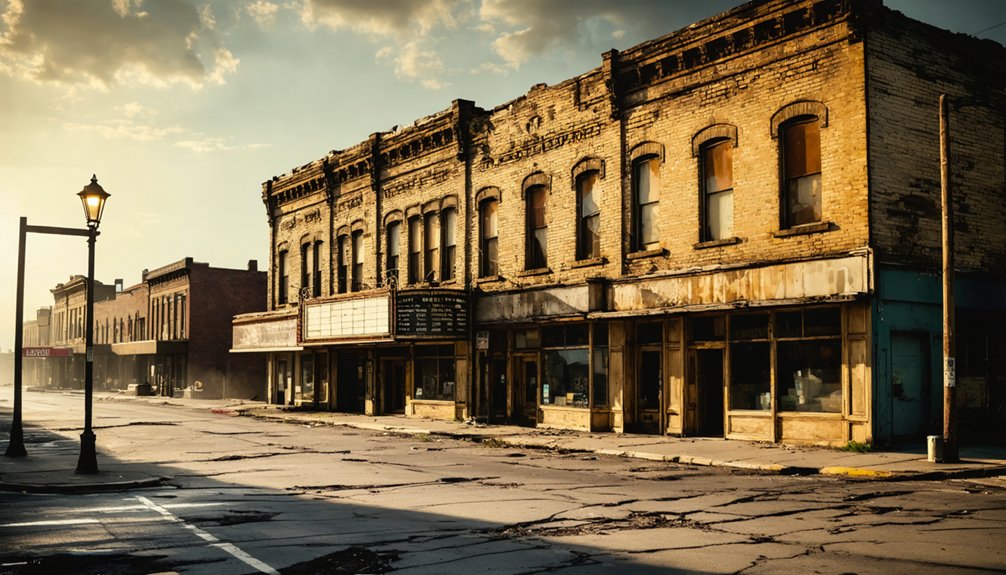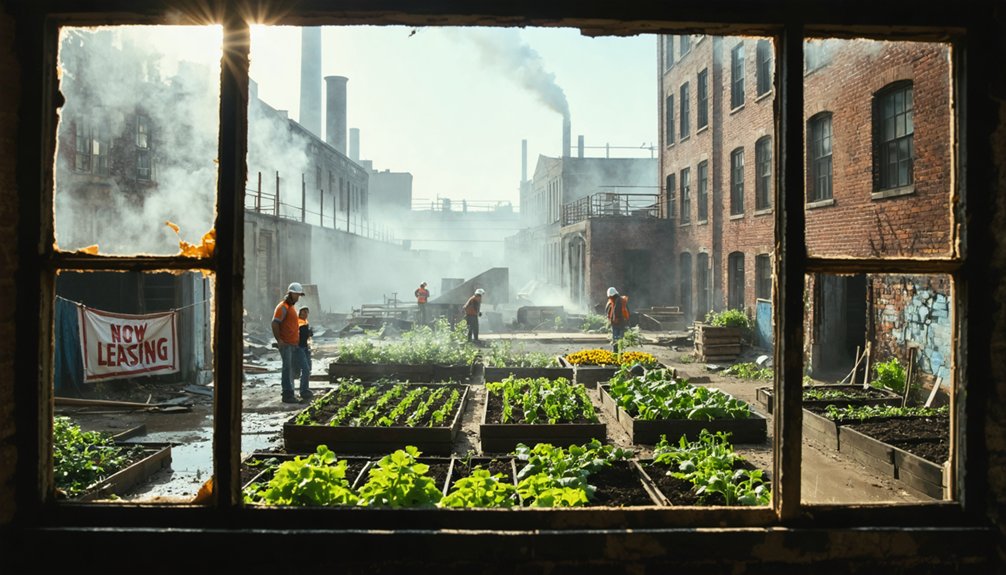The Rust Belt’s abandoned towns tell America’s deindustrialization story through their silent factories and empty streets. You’ll find Danville’s shuttered textile mills, Johnstown’s vacant storefronts, Muncie’s automotive ghosts, Detroit’s half-erased McDougall-Hunt neighborhood, and Gary’s steel town collapse. These industrial graveyards represent more than decay—they embody communities fractured by economic upheaval and environmental consequences. Their haunting landscapes reveal both cautionary tales and the stubborn resilience of post-industrial identity.
Key Takeaways
- Gary, Indiana transformed from a U.S. Steel powerhouse to a symbol of abandonment, with population loss and widespread vacant properties.
- Johnstown, Pennsylvania’s economic collapse following Bethlehem Steel’s closure created ghost-like downtown areas with numerous empty historic buildings.
- Danville, Virginia suffered dramatic decline after Dan River Mills closed in 2008, losing its economic foundation and community identity.
- Muncie, Indiana’s manufacturing exodus left abandoned factories like BorgWarner and Chevrolet as industrial ruins amid population decline.
- Abandoned industrial sites throughout the Rust Belt have attracted paranormal tourism and urban explorers documenting America’s manufacturing decline.
Danville: When the Textile Mills Went Silent
As the 19th century drew to a close, Danville, Virginia emerged as a powerful center of textile manufacturing with the establishment of Riverside Cotton Mills in 1882.
What became Dan River Mills would soon dominate the landscape, employing 14,000 workers—more than a third of the town’s population.
If you’d visited during the industry’s heyday, you’d have witnessed a community defined by textile nostalgia, where generations of families worked the looms and spindles.
The impressive Mill No. 8, now known as Dan River Falls, stood as a monument to simplified Gothic Revival architecture when built in 1920.
The mill village of Schoolfield fostered tight-knit relationships, creating bonds that outlasted the mills themselves.
Schoolfield’s streets were intentionally designed to lead directly to the mill without intersections, reinforcing the community’s singular purpose.
This community resilience would be tested when globalization struck.
After bankruptcy in 2004 and closure in 2008, the imploded mills left Danville reeling.
The sudden industrial collapse shattered Danville’s economic foundation, leaving a community searching for purpose amid the ruins.
Today, efforts to reimagine these industrial spaces represent both a remembrance of the past and the search for a new identity.
Johnstown’s Steel Legacy: A City of Empty Storefronts
Walking through downtown Johnstown today, you’ll confront the stark reality of empty storefronts that echo the collapse of what was once America’s model steel city.
From its 1852 origins as Cambria Iron Company through its heyday under Bethlehem Steel when 11,800 workers filled its mills, Johnstown exemplified industrial might until the 1992 closure severed generations of families from their economic lifeline. The Forging a Nation exhibition opened in February 2024 aims to preserve this crucial industrial history from the 1700s to the present. The site was designated a National Historic Landmark in 1989, recognizing its pivotal role in American industrial history despite its eventual decline.
These vacant commercial corridors represent more than abandoned buildings—they embody the human cost of deindustrialization that transformed a thriving industrial powerhouse into a struggling Rust Belt casualty.
Once-Mighty Industrial Giant
The Johnstown steel industry, once a cornerstone of American manufacturing prowess, began its remarkable ascent in 1852 with the formation of Cambria Iron Company.
Through industrial innovation spearheaded by engineers like Kelly, Fritz, and Holley, the mill rapidly became a national leader in rail production, strategically bolstered by the Pennsylvania Railroad’s arrival in 1854.
You can still witness the remnants of this industrial titan that transformed a small town into a manufacturing hub.
Workforce migration brought thousands of immigrants, primarily from Southern and Eastern Europe, creating vibrant neighborhoods like Cambria City.
The decline in local coal quality eventually contributed to challenges facing Johnstown’s steel production operations.
By 1973, the plant employed 11,800 workers at its peak, before Bethlehem Steel’s 1992 closure ended 140 years of production.
The widespread use of asbestos materials throughout the facility led to serious health consequences for many workers decades after exposure.
Today, the abandoned structures stand as haunting monuments to America’s industrial might—silent witnesses to both innovation and decline.
Downtown Ghost Corridors
Downtown Johnstown’s once-vibrant commercial district now stretches before visitors as a haunting memorial to industrial collapse, with block after block of vacant storefronts standing in silent tribute to vanished prosperity.
You’ll find historic pre-1949 buildings like the David Dibert and Mayer structures sitting empty, their architectural grandeur fading beneath decades of neglect.
The 1889 flood’s devastation lingers in both physical scars and psychological memory, contributing to Johnstown’s reputation as Pennsylvania’s most haunted downtown.
This abandonment has ironically created opportunity through paranormal tourism, with ghost tours drawing visitors to empty corridors where flood victims’ stories echo through abandoned commercial spaces.
The museum’s exhibits chronicle how survivors encountered grotesque scenes of bodies along riverbanks, many stripped of clothing by the violent waters.
Visitors can also explore the nearby Ghost Town Trail that spans 46 miles through former coal-mining communities, offering both recreational opportunities and historical context for the region’s industrial decline.
These haunted narratives offer potential pathways to urban revitalization, transforming economic tragedy into cultural asset as downtown’s emptiness itself becomes a marketable experience amid the larger rust belt decline.
Generations Lost Employment
Steel’s abandonment echoes through generations in Johnstown, where the 1992 closure of Bethlehem Steel’s operations marked the culmination of a 140-year industrial legacy.
You’ll find the impact rippling through families where grandfathers, fathers, and sons once shared not just bloodlines but paycheck sources. When 11,800 jobs vanished overnight, they took with them more than employment—they erased identities.
The generational unemployment created a profound economic legacy.
As you walk through neighborhoods like Cambria City, once vibrant with immigrant families drawn by steel’s promise, you’ll see the hollowed remnants of multi-generational stability.
The exodus that followed wasn’t just about seeking jobs elsewhere; it represented the fracturing of community bonds forged in molten metal and sustained through shared prosperity.
Muncie’s Manufacturing Ghost: From Boom to Abandonment
Walking through Muncie today, you’ll encounter the stark juxtaposition of a once-thriving industrial powerhouse now marked by abandoned factories and declining neighborhoods.
The transformation from a city where manufacturing employed 21% of the population in 1972 to one with less than 7% by 2000 represents one of the most dramatic examples of Rust Belt decline in America.
These manufacturing ghosts—empty BorgWarner facilities, the shuttered Chevrolet plant, and vacant worker housing—stand as three-dimensional artifacts of prosperity collapsed under the weight of globalization and economic restructuring.
The city’s economic struggles were worsened by the closure of GM’s Delphi plant and Borg-Warner’s manual transmission business, which represented major disruptions to the local employment landscape.
Like many Midwest towns that developed around a single industry, Muncie’s dependence on manufacturing left it vulnerable when economic conditions changed.
Prosperity to Collapse
Once a quintessential American success story, Muncie, Indiana transformed from a modest Midwestern town into a manufacturing powerhouse during the late 19th century, propelled by the fortuitous discovery of natural gas deposits that attracted energy-intensive industries.
You’d hardly recognize the vibrant industrial hub of mid-century Muncie today. Its manufacturing legacy, once defined by thriving automobile parts factories, glass production, and Ball jar manufacturing, has largely vanished.
The economic resilience that carried the city through early challenges collapsed under cascading plant closures. When Chevrolet shuttered its 3,000-employee plant in 2006, followed by Borg-Warner’s closure in 2009, Muncie’s industrial foundation crumbled.
Manufacturing employment plummeted from over 12,000 jobs in the 1990s to fewer than 4,000 by 2020, leaving behind abandoned factories and a shrinking population struggling with nearly 10% unemployment by 2011.
Neighborhoods Frozen in Time
The physical remnants of Muncie’s industrial collapse now haunt its once-thriving neighborhoods, creating eerie time capsules of American manufacturing’s heyday.
Walking these streets, you’ll encounter boarded-up homes and overgrown lots where neighborhood nostalgia lingers in abandoned churches and shuttered corner stores.
What you’re witnessing reflects more than building decay—it’s the unraveling of community fabric. As manufacturing jobs plummeted from 12,000 to 3,900 between 1995 and 2020, families departed, leaving weakened social institutions behind.
The closures of Delphi, Chevrolet, and BorgWarner factories didn’t just eliminate paychecks; they dismantled neighborhood identities.
Despite glimpses of economic resilience in smaller operations like Keihin, these communities remain frozen between their industrial past and an uncertain future, challenging Muncie’s historic identity as “Middletown USA.”
Detroit’s McDougall-Hunt: A Neighborhood Half-Erased

While many Rust Belt cities bear the scars of industrial collapse, few neighborhoods embody the stark reality of urban abandonment as vividly as Detroit’s McDougall-Hunt. You’ll find a landscape where more than half the homes have vanished, leaving vacant lots where families once lived.
Unlike areas cleared through planned urban renewal, McDougall-Hunt faded through gradual abandonment—a death by a thousand cuts.
McDougall-Hunt’s decay came not through calculated urban planning, but through slow, painful attrition—homes surrendered one by one to neglect.
What makes this neighborhood remarkable is its embodiment of community resilience despite overwhelming challenges. The internationally recognized Heidelberg Project transformed abandoned properties into art installations, creating a cultural landmark amid the blight.
This artistic intervention represents local resistance to erasure, offering both commentary on the neighborhood’s decline and a vision for its possible rebirth, even as demolitions continue to reshape its physical landscape.
Gary: How a Steel Giant Became a Shell of Its Former Self
Unlike Detroit’s gradual neighborhood decline, Gary, Indiana represents a more thorough civic collapse, transforming from America’s premier steel town to an emblematic shell of Rust Belt abandonment.
Founded in 1906 by U.S. Steel as a company town, Gary rapidly flourished around what became the world’s largest steel mill. You’d have seen a bustling “City of the Century” at its 1970 peak, when 32,000 steelworkers supported a population of 175,415.
Gary’s steel legacy crumbled dramatically as foreign competition, automation, and declining demand devastated its economic foundation. By 2005, steel employment plummeted to just 7,000 workers.
This economic decline triggered cascading problems—massive population loss, urban decay, and entrenched poverty. Despite electing pioneering Black mayor Richard Hatcher and later development initiatives, the city continues struggling to overcome its industrial past.
The Hidden Stories Behind Rust Belt’s Factory Ruins

Beyond Gary’s specific decline lies a broader landscape of industrial ruins that dot Rust Belt cities, each abandoned factory telling its own story of America’s manufacturing zenith and subsequent fall.
These crumbling structures reveal hidden narratives of prosperity that vanished when companies relocated overseas between the 1950s and 1980s.
Each fallen brick and rusted beam whispers stories of American prosperity before globalization’s exodus.
You’ll find in these sites not just industrial decay, but physical manifestations of communities that lost two-thirds of their manufacturing jobs and watched as populations plummeted by over 40% in cities like Cleveland and Detroit.
The ruins embody both environmental consequences—contaminated lands and hazardous materials—and cultural significance as symbols of lost identity.
While some structures find new life through preservation efforts and tourism, most remain silent witnesses to America’s painful economic transformation, their concrete and steel frames housing the ghosts of a vanished industrial era.
Exploring America’s Industrial Graveyards: Safety and Significance
As you venture into America’s industrial graveyards, you’ll encounter not merely abandoned structures but complex landscapes that demand both respect for their historical significance and awareness of their inherent dangers.
Urban exploration through Detroit’s crumbling factories or St. Louis’s abandoned neighborhoods reveals the stark reality of America’s manufacturing collapse, where population declines of 60-70% have left behind unstable structures and environmental hazards.
While these sites offer powerful glimpses into industrial heritage, they’re fraught with safety hazards—collapsing infrastructure, hazardous materials, and legal consequences for trespassing.
Steel mills in Gary and automotive plants in Shreveport stand as both historical artifacts and dangerous remnants. Your exploration connects you with America’s industrial past, but demands caution amid the deteriorating remnants of once-thriving communities.
Frequently Asked Questions
Are There Efforts to Revitalize These Towns Through Tourism?
Like phoenix cities rising from industrial ashes, you’ll find numerous tourism initiatives throughout the Rust Belt, with community engagement driving heritage museums, cultural hubs, breweries, and festivals that honor local history while generating revenue.
What Environmental Contamination Remains in Abandoned Industrial Sites?
You’ll find a toxic legacy of heavy metals, PAHs, VOCs, PFAS, and asbestos contaminating soil, groundwater, and air in these sites, despite ongoing remediation efforts to reclaim brownfields for future use.
How Do Current Residents Feel About Urban Explorers?
Like watchdogs over fading memories, you’ll find residents harbor mixed feelings. Their perceptions of urban exploration typically skew negative—viewing you as trespassers who profit from their community’s hardship without understanding their lived reality.
What Happened to the Workforce Skills After Industries Collapsed?
You’re witnessing significant skill degradation as manufacturing workers couldn’t transfer specialized abilities to emerging sectors. Workforce retraining efforts often failed due to educational gaps and structural barriers limiting occupational mobility.
Are Any Towns Successfully Transitioning to New Economic Models?
Like phoenixes rising from industrial ashes, you’ll find numerous Rust Belt towns embracing tech innovation and sustainable agriculture, particularly in university-anchored communities that foster public-private partnerships supporting diversified, knowledge-based economic models.
References
- https://www.industryweek.com/talent/article/22028380/the-abandonment-of-small-cities-in-the-rust-belt
- https://environment.sfsu.edu/sites/default/files/2023-02/AS362011GEOGS74.pdf
- https://schoolofcities.utoronto.ca/neighbourhood-abandonment-in-the-american-rust-belt/
- https://handbill.hk/editor_upload/file/1f47de58-e829-419c-ab5d-deae4a07d2ca.pdf
- https://www.youtube.com/watch?v=g00kMsxdpJ8
- https://www.geotab.com/ghost-towns/
- https://www.loveexploring.com/gallerylist/127789/then-and-now-us-rust-belt-cities-that-bounced-back
- https://en.wikipedia.org/wiki/Rust_Belt
- https://247wallst.com/housing/2024/08/26/31-of-homes-in-this-american-ghost-town-are-vacant/
- https://danriverfalls.com/history/



